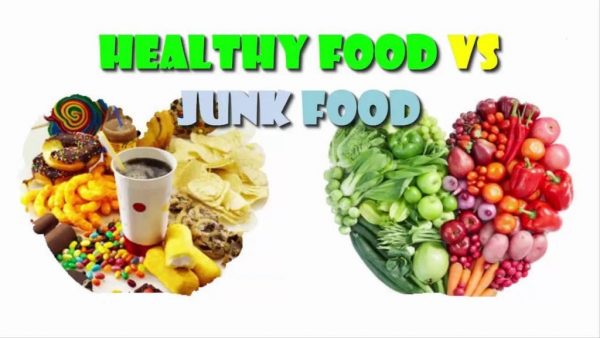When you’re super-busy, running from soccer practice to study group, it’s easy to call dinner a slice of pizza and chocolate-dipped granola bar. But just because something tastes good — and you can eat it on the go — doesn’t mean it’s healthy.
Fatty and high-sugar foods like pizza, soda, chips, cookies, and fruit drinks “contain the wrong type of fuel for filling you up and helping you feel your best,” says Torey Armul, RDN, spokesperson for the Academy of Nutrition and Dietetics.
“Empty calorie” foods like these actually have lots of calories. But they don’t fill you up. And they have little to none of the nutrients your body needs. So instead of giving you energy to exercise, feel good, and make other healthy choices, they’ll leave you zapped and feeling blah.If they make up too many of your meals, you may find it harder to control your weight, too. And that can lead to serious health problems down the road.
But don’t worry: healthy meals don’t mean you’ll be munching on nothing but kale leaves and carrot sticks forever. They’re tastier (and a lot less work) than you probably think.
Build a Balanced Diet
It’s OK to eat a food every once in a while just because it tastes good. (Why else do curly fries exist?) But for almost every meal and snack, choose foods that have vitamins and minerals or are high in fiber and protein to fill you up and give you energy.
A good plan to follow for each meal:
- Fill half your plate with fruits and vegetables.
- Fill one-quarter with lean protein like chicken, fish, beans, or tofu.
- The last quarter of your plate should be whole grains like brown rice, a whole-wheat tortilla, or oatmeal.
- Don’t forget to add a serving of dairy, like yogurt, cheese, soy milk, or skim or low-fat milk.
What to Cut Back On
Saturated fats, like you find in meat and butter, and trans fats, which are in many baked goods, put more fat in your blood. That’s bad for your heart.
If you’re like most teens, you eat close to 34 teaspoons of added sugar each day. Try to limit sweets and processed foods (candy, soda, sugary cereal), which tend to sneak in sugar under different names like “corn syrup” or “fructose.”
Also, 90% of kids eat way too much salt, which stresses your heart. Steer clear of ready-to-eat foods (frozen burritos, pizza rolls, ramen noodles), which often have tons of it, as do bread and rolls, salty snacks, cold cuts, and pizza.
Healthy Meals to Make at Home
You’ll have more control over what you eat if you cook dinner at home. That doesn’t have to involve fancy ingredients or a lot of time. Here are some quick meals you can make yourself:
- DIY Burrito: Fill a whole-wheat tortilla with canned black beans, fresh spinach, half an avocado, salsa, and grated cheese.
- Egg Scramble: Scramble 2-3 eggs, then throw in diced veggies (peppers, tomatoes, spinach) and shredded cheddar.
- Tuna Melt: Mix a tuna packet with low-fat mayo, then spoon it onto a toasted whole-wheat English muffin. Top with a slice of pepper jack or cheddar cheese.
- Protein Smoothie: In a blender, mix 1-2 cups of frozen fruit with 6 ounces of Greek yogurt or milk, 1 tablespoon or a small packet of flaxseed, and 1 cup water.
- Rice and Veggie Steamer: Use the microwave to heat up a single serving bag of frozen veggies and a package of brown or wild rice. Add protein like canned beans or grilled chicken strips, then flavor with low-sodium soy sauce, marinara, or jarred pesto.
Better Choices on the Go
If you usually grab dinner out, try these easy swaps for a healthier — but still tasty — meal.
- Instead of a burger and fries: Order a turkey burger or grilled chicken sandwich with a side salad. You’ll get just as much protein, minus all the saturated fat. The salad has more fiber to fill you up — and without the loads of salty, greasy fries.
- When you order pizza: Ask for a thin crust with veggie toppings. “Thin crust has far fewer calories than thick crust or deep dish,” Armul says.
- Instead of a soda: Order water or plain iced tea. Regular sodas and sweet teas are loaded with sugar and the calories add up quickly.
- When you order a fruit smoothie: Skip any version with added sugar or fruit juice. These turn any drink into a serious calorie-bomb. To increase the smoothie’s staying power, look for one with protein powder, milk, or yogurt.
No one’s asking you to give up ice cream or nachos for good, by the way. “It’s OK to indulge every once in a while,” Armul says, “but try to fill up first on healthy foods, and always practice portion control.”
And no matter how busy you are, don’t skip dinner. If you let yourself get too hungry, there’s a good chance you’ll overeat — and then healthy foods will probably be the last thing on your mind.
By Stephanie Booth
WebMD Feature
Latest posts by Jenny (see all)
- Tackle Game Day Temptations - February 2, 2021
- Staying Healthy During the Pandemic - May 22, 2020
- Free At Home Workouts - March 20, 2020
